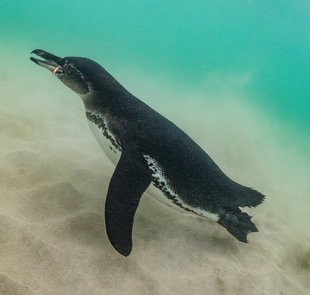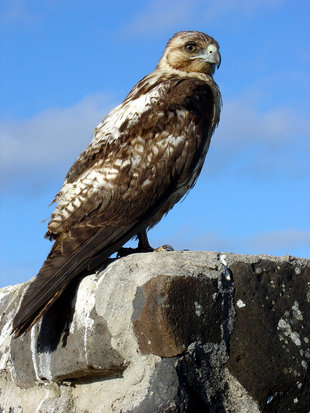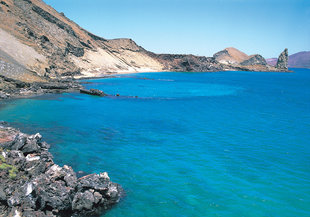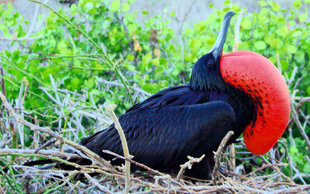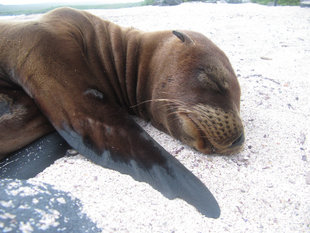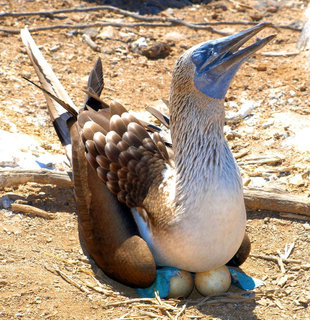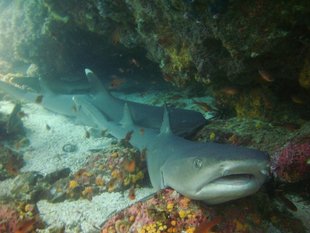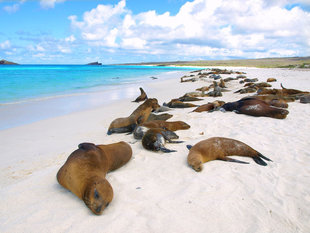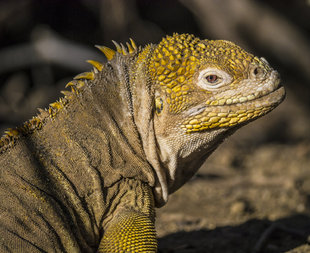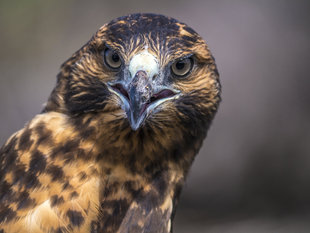Area Size: 1.3 Km²
Maximum Altitude: 114 meters / 374 feet
Island Highlights: Galapagos Penguin, Galapagos Hawk, White Tip Reef Shark, Sea Lion, Pinnacle Rock, Cousins Rock
Introduction
Bartolomé (Bartholomew) is a volcanic islet situated just off the east coast of Santiago Island and is one of the youngest islands in the Galapagos archipelago. Despite being fairly desolate and harbouring little plant life, it is scenically unique making Bartolomé the most visited and most photographed island in the Galapagos archipelago.
The island is characterised by its fascinating geology and incredible volcanic formations and in particular that of Pinnacle Rock. Historically, Pinnacle Rock was used as a target for US airmen in World War 2. The island offers beautiful white sandy beaches, fringed by luscious green mangroves.
You can explore Bartolome with Aqua-Firma by joining one of our Galapagos Wildlife Yacht Safaris or Yacht & Lodge Safaris. We also stop there on some Dive Liveaboard trips. Other liveaboard trips will often pass by the rock providing excellent views.
Wildlife
In terms of wildlife on Bartolomé, there is not a large amount to see in comparison to some of the other islands. However, the wildlife that does reside here is definitely worth looking out for.
The area surrounding Pinnacle Rock presents a variety of interesting wildlife, including lava lizards, which can be hard to spot as they lie well camouflaged on the rocks and in the sand. It is also common to see colourful grasshoppers in amongst the hardy pioneer plants, while blue-footed boobies and frigatebirds are often spotted perched on nearby cliffs and trees.
Marine Life
Bartolomé's best snorkelling location is indisputably Pinnacle Rock. The waters surrounding Pinnacle Rock provide a wonderful array of exotic marine life, including beautiful shoals of tropical fish, sea urchins, star fish and anemones. This is also a good location for spotting white tip reef sharks, stingrays and spotted eagle rays. Other marine life to be found here includes large starfish, blennies and schools of butterfly fish. Sea lions can usually be seen basking in the sun on platforms or the nearby beach, so it is wise not to go on land here.
Bartolomé is probably the Galapagos's easiest spot to snorkel with Galapagos penguins. Out of the water they often walk along the precarious ledges at the base of Pinnacle Rock. These half metre tall penguins power through the water at the speed of light, but are just as likely to be seen standing proudly on the rocks above, mocking the inferior snorkelers beneath them. Interestingly, Galapagos penguins have a strong sense of personal space and tend to enjoy their own company: therefore they are more often than not seen standing a fair distance apart from one another.
Just north of Bartolomé lies Cousins Rock, a rock which rises some 10 metres above the water and is home to passing birds and sea lions. The sea lions often slide down the rocks to greet divers as they enter the water. The stepped wall is awash with black coral bushes interspersed with dazzling tones of gold and yellow. Longnose hawkfish, the unusual blue-eyed damsel and Galapagos seahorses can often be spotted flitting amongst the branches. Opportunities to see beautiful starfish and groups of whitetip sharks can be sought on sandy bottom ledges, while there are also good chances to encounter schools of tiny snapper and small pelican barracuda. Further down the wall divers descend, chances to see rays of all varieties arise. This dive is almost always accompanied by sea lions, which playfully glide around divers.
All of our Dive Liveaboard trips currently include diving at Cousins. We also visit Cousins weekly during our Hotel Based Galapagos Diving trips.
Geology
Bartolomé Island comprises an extinct volcano and a colourful collection of red, orange, green and glistening black volcanic formations. One particularly interesting rock formation is that of a volcanic cone, which makes a worthwhile climb and presents some spectacular panoramic views of the neighbouring islands. A 600 meter pathway consisting of a wooden staircase and boardwalk, the trail eventually leads to Bartolomé's summit, providing excellent opportunities to photograph Pinnacle Rock. This fairly easy walk presents a multitude of volcanic features including cones and lava tubes at various stages of erosion.
Undoubtedly one of the most distinctive landmarks on Bartolomé and arguably of the Galapagos archipelago is Pinnacle Rock: a tall and slightly leaning tuff cone that rises from the islands' coastline. On the eastern edge of the pinnacle lies a beautiful crescent shaped sandy beach, a haven for both swimmers and snorkelers alike. As a popular nesting site, sea turtles can often be seen ambling along the shoreline here.
Bartolome

